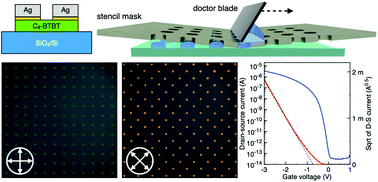Stencil mask defined doctor blade printing of organic single crystal arrays for high-performance organic field-effect transistors†
Abstract
Organic field-effect transistors (OFETs) are one of the promising candidates for next generation electronics due to their solution processability and good performance superior to amorphous Si devices. Patterning the organic layer is necessary in practical applications to prevent cross talk between different devices. Here, we reported a novel solution processed, high-resolution patterning method named as stencil mask defined doctor blade printing to fabricate regularly patterned organic single crystal arrays. The size of one pattern is around 30 μm, which is smaller than the droplet diameter of conventional inkjet printing. The OFETs based on organic single crystal patterns exhibit extremely low off-state current and high on/off current ratio close to 1010 as well as good device uniformity. The low off-state current demonstrates the potential of the OFET array for low-power or high-performance optical sensing applications. In addition, the short channel OFET array exhibits good frequency response operating at 20 kHz. This work provides an effective patterning strategy to realize solution processed large-area, high-resolution organic single crystal arrays.

- This article is part of the themed collection: 2021 Materials Chemistry Frontiers HOT articles


 Please wait while we load your content...
Please wait while we load your content...